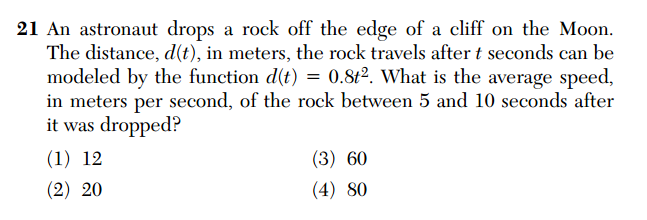Regents Recap — January 2015: Gravity on the Moon
Here is another installment in my series reviewing the NY State Regents exams in mathematics.
There is something of a history with Regents exams and the force of gravity.
An infamous problem years ago modeled a falling object with the quadratic function
.
This would imply that the acceleration due to gravity, or g, would be equal to 4 f/s², not the -32 f/s² we are accustomed to. This amusing error inspired my talk “g = 4, and Other Lies the Test Told Me“.
So, it was interesting to see projectile motion appear twice in the most recent round of math Regents exams. This is from the Integrated Algebra exam.
I was pleasantly surprised to see the proper coefficient!
And then I noticed a second appearance of gravity. This is from the Common Core Algebra exam.
Of course, I had to check. Kudos to the exam writers for looking up the actual force of gravity on the moon. If we’re going to go to the trouble of trying to establish “real world” contexts for these problems, we should make sure physical forces are accurately represented.

1 Comment
Curmudgeon · November 26, 2015 at 6:37 pm
Hang on …. If the rocket is shot out of a cannon and is in free fall the entire flight, then the equation should be -16t^2 + 32x, but the problem states that it is launched. To me, that means the rocket is firing (positive acceleration)for a significant amount of the upwards portion of the flight. The initial velocity is zero, then increases to and continues at some fixed amount before it shuts off and then the rocket coasts upwards. That is most definitely not a parabolic model, at least up to engine shut-off. After that, air resistance is significant in model rockets.
I know it’s nit-pick, but I’ve gotta say the writer still messed up.